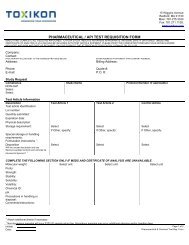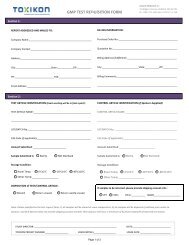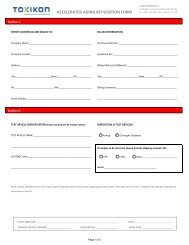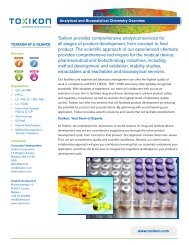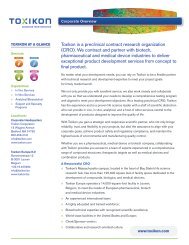Medical Device Testing Guide - Toxikon Corporation
Medical Device Testing Guide - Toxikon Corporation
Medical Device Testing Guide - Toxikon Corporation
Create successful ePaper yourself
Turn your PDF publications into a flip-book with our unique Google optimized e-Paper software.
METALS ANALYSIS<br />
Rev. May 2010<br />
UD01-1<br />
Heavy Metals—USP Method I- Sample needed: 20 grams<br />
This test measures whether metallic impurities in a test article exceed the Heavy Metals limit for lead. Analysis is based on the<br />
color reaction between lead and organically bound sulfur. Individual color-comparison tubes are filled with test-article extract,<br />
reference standard lead solution and mixture of the two. The solutions are acidified and then mixed with thioacetamide. The color<br />
of the reaction products are compared.<br />
Approximate turnaround time is two to three weeks.<br />
UD02-1<br />
Heavy Metals Analysis –for 8 elements-Sample needed: depends on testing requirements<br />
This test determines the level of 8 common heavy metals (arsenic, barium, cadmium, chromium, lead, mercury, selenium and<br />
silver) in liquid, biological tissue, solid material, or extract of a solid material. Tissues or digestable solids are first acid<br />
digested to eliminate interference from proteins and other compounds. Procedure makes use of internal standards. Sample<br />
processing for mercury is separate from that used for the other metals, because mercury is analyzed by atomic absorption<br />
spectroscopy and the others by inductively-coupled-plasma spectroscopy using either emission spectrometer or mass<br />
spectrometer as detector. Per request, analytical service for quantifying analyte(s) includes validation of assay method.<br />
Approximate turnaround time is two to three weeks.<br />
UD03-1<br />
UD03-2<br />
Metals Analysis – Screening (ICP)-Sample needed: 10 mL<br />
Metals Analysis – Screening (ICP/MS)-Sample needed: 25 mL<br />
This test determines the amount and types of metallic elements present in a liquid, biological tissue, solid material or extract of<br />
a solid material. Sample preparation involves acid digestion of tissues and digestable solids to eliminate interference from<br />
proteins and other compounds. Procedure makes use of internal standards. Final solution, be it an extract or filtered acid<br />
digest, is analyzed by inductively-coupled-plasma spectroscopy using either emission spectrometer or mass spectrometer as<br />
detector. Following metals are measured in a standard test: aluminum, antimony, arsenic, barium, beryllium, boron, cadmium,<br />
calcium, chromium, cobalt, copper, iron, lead, magnesium, molybdenum, manganese, nickel, potassium, selenium, silver,<br />
sodium, thallium, titanium, vanadium and zinc. Analyses of other elements are also available.<br />
Approximate turnaround time is two to three weeks.<br />
UD04-1<br />
Mercury Analysis-Sample needed: depends on testing requirements<br />
This test determines the level of mercury in a liquid, solid material or extract of a solid material. Samples are digested in acid<br />
and then oxidized with persulfate or permanganate. Mercury is measured by atomic absorption spectroscopy.<br />
Approximate turnaround time is two to three weeks.<br />
MATERIAL ANALYSIS<br />
UE01-1<br />
Conductivity USP-Sample needed: 50 mL or per specified extraction ratio<br />
Conductivity is a test for the presence of dissolved ions. When dissolved in water, most inorganic and some organic<br />
compounds dissociate into ions. Ions are charged and, being mobile, they are electrical conductors. Conductivity testing is<br />
performed on either a supplied water sample or water extract of a solid test article. In the latter case, test article is extracted with<br />
an aqueous matrix under Sponsor-specified conditions. Conductivity results are reported in units of S/cm.<br />
Approximate turnaround time is one to two weeks.<br />
UE02-1<br />
Total Organic Carbon (TOC) USP-Sample needed: 45 mL or per specified extraction ratio<br />
This test determines the amount of carbon present in organic compounds within an aqueous sample. The test article may be an<br />
aqueous solution, or the aqueous extract of a solid test article, for which extraction is Sponsor specified. The analytical process<br />
involves converting organic compounds to carbon dioxide by a sequence of acidification and oxidation reactions. Liberated carbon<br />
dioxide is quantified with an infrared detector.<br />
Approximate turnaround time is two to three weeks.<br />
15 Wiggins Avenue, Bedford, MA 01730 781.275.3330 www.toxikon.com



